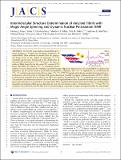Intermolecular Structure Determination of Amyloid Fibrils with 2 Magic-Angle Spinning and Dynamic Nuclear Polarization NMR
Author(s)
Bayro, Marvin J.; Debelouchina, Galia Tzvetanova; Eddy, Matthew Thomas; Birkett, Neil R.; MacPhee, Catherine E.; Rosay, Melanie; Maas, Werner; Dobson, Christopher M.; Griffin, Robert Guy; ... Show more Show less
DownloadBayro_JACS_2011.pdf (4.125Mb)
PUBLISHER_POLICY
Publisher Policy
Article is made available in accordance with the publisher's policy and may be subject to US copyright law. Please refer to the publisher's site for terms of use.
Terms of use
Metadata
Show full item recordAbstract
We describe magic-angle spinning NMR experiments designed to elucidate the interstrand architecture of amyloid fibrils. Three methods are introduced for this purpose, two being based on the analysis of long-range [superscript 13]C–[superscript 13]C correlation spectra and the third based on the identification of intermolecular interactions in [superscript 13]C–[superscript 15]N spectra. We show, in studies of fibrils formed by the 86-residue SH3 domain of PI3 kinase (PI3-SH3 or PI3K-SH3), that efficient [superscript 13]C–[superscript 13]C correlation spectra display a resonance degeneracy that establishes a parallel, in-register alignment of the proteins in the amyloid fibrils. In addition, this degeneracy can be circumvented to yield direct intermolecular constraints. The [superscript 13]C–[superscript 13]C experiments are corroborated by [superscript 15]N–[superscript 13]C correlation spectra obtained from a mixed [[superscript 15]N,[superscript 12]C]/[[superscript 14]N,[superscript 13]C] sample which directly quantify interstrand distances. Furthermore, when the spectra are recorded with signal enhancement provided by dynamic nuclear polarization (DNP) at 100 K, we demonstrate a dramatic increase (from 23 to 52) in the number of intermolecular [superscript 15]N–[superscript 13]C constraints detectable in the spectra. The increase in the information content is due to the enhanced signal intensities and to the fact that dynamic processes, leading to spectral intensity losses, are quenched at low temperatures. Thus, acquisition of low temperature spectra addresses a problem that is frequently encountered in MAS spectra of proteins. In total, the experiments provide 111 intermolecular [superscript 13]C–[superscript 13]C and [superscript 15]N–[superscript 13]C constraints that establish that the PI3-SH3 protein strands are aligned in a parallel, in-register arrangement within the amyloid fibril.
Date issued
2011-07Department
Massachusetts Institute of Technology. Department of Chemistry; Francis Bitter Magnet Laboratory (Massachusetts Institute of Technology)Journal
Journal of the American Chemical Society
Publisher
American Chemical Society (ACS)
Citation
Bayro, Marvin J. et al. “Intermolecular Structure Determination of Amyloid Fibrils with Magic-Angle Spinning and Dynamic Nuclear Polarization NMR.” Journal of the American Chemical Society 133.35 (2011): 13967–13974.
Version: Author's final manuscript
ISSN
0002-7863
1520-5126